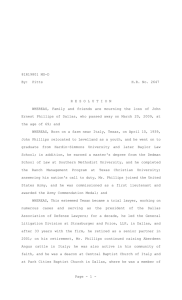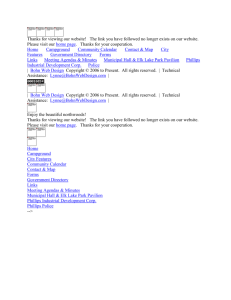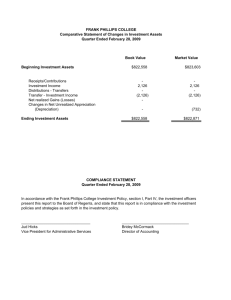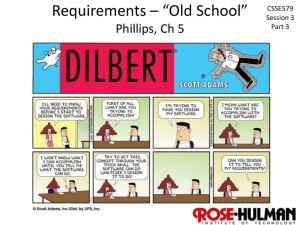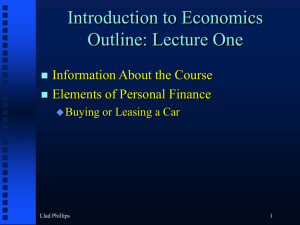Lecture14 - UCSB Economics
advertisement
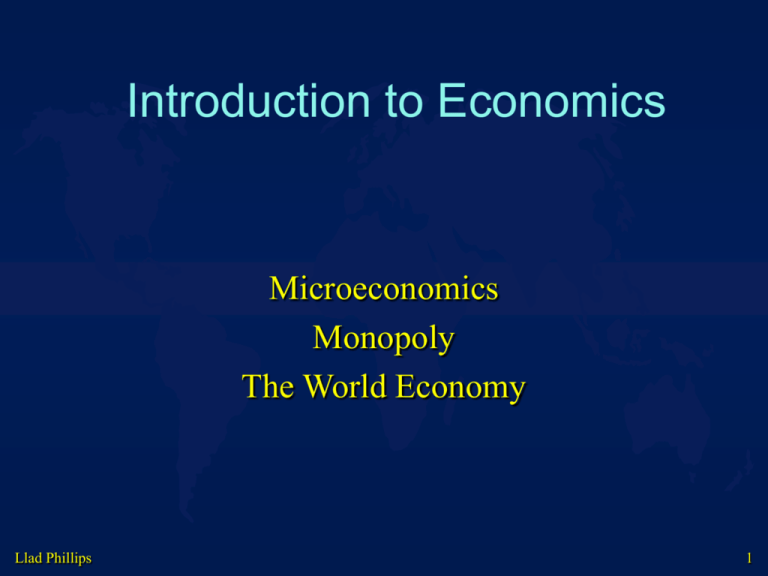
Introduction to Economics Microeconomics Monopoly The World Economy Llad Phillips 1 Econ 109 Llad Phillips Example Questions for the Final 11/19/98 III. (40 points) Answer all four questions. 1. The curves below illustrate the average product of labor, APL, and the marginal product of labor, MPL, for a developing country. The annual rate of growth of population in this agricultural country is high, and technological progress is negligible. a. Illustrate the fact that the working population in this “Malthusian” country is at the subsistence wage. b. What keeps the workers at a subsistence wage? c. Label the portion of total output going to labor as the “wage bill”. d. What is the total output of the country? Label it on the graph. e. The difference between the total output and the wage bill is the output going to the landowner class. Label it on the graph. Output MPL APL Number of Workers Llad Phillips 2 The Brief for Microsoft The case for monopoly: Joseph Schumpeter Growth is the key to social welfare Large and growing firms reinvest profits in future growth – capital deepening Large and growing firms have the resources to invest in research and development – technological change improves productivity Llad Phillips 3 The Brief for Microsoft Consumers have not been hurt by Microsoft In contrast, consumers have benefited Any market power Microsoft has is tenuous in the rapidly growing and changing software industry Llad Phillips 4 Microsoft Trial Against Microsoft – predatory behavior towards competitors – acting in restraint of competition Llad Phillips For Microsoft – may have hurt competitors but not “competition” – consumers have benefited because of Microsoft and have certainly not been hurt 5 Microsoft Trial Slate Magazine – http://www.slate.com The Microsoft Trial Message #10: Nov. 13, 1998 From: Jodie T. Allen To: Slate - dispatch Jodie T. Allen is Slate's Washington editor. Day 16 of the Trial Llad Phillips 6 I will not pretend to be an objective observer of the Microsoft trial. You wouldn't believe me if I did. Unlike my predecessors in this assignment, I am bound by ties, both sympathetic and financial, to the corporation whose rise to power and affluence has earned it the enmity of the Justice Department's antitrust division. My early working years as a computer model builder in the era of IBM hegemony also gave me a strong appreciation for the virtues of compatibility. And I grew up rooting for the Yankees. Llad Phillips 7 For a Microsoft retainer, this might seem to be a pretty good day for a courtroom visit. Microsoft spent the morning in full attack on Steven McGeady, the Intel executive who has charged that Microsoft strong-armed Intel into abandoning work on Native Signal Processing--a multimedia software project McGeady managed--and pressured the chipmaker to stay out of software programming in general. It displayed a string of e-mails and memos between and among Microsoft and Intel executives plus McGeady's own handwritten notes. Some were long and dull, some short and amusing. One, a note from Intel CEO Andrew Grove to Microsoft CEO Bill Gates after a July 1995 dinner they shared concludes with a "smiley face." Llad Phillips 8 Outline: Lecture Fourteen-Trade The Western Movement: Manifest Destiny – Autarchy self-sufficiency – The Advantages of Exchange specialization The Political Economy of Trade – Arguments for Free Trade – Arguments Against Free Trade Llad Phillips 9 Autarchy Self-Sufficient Economy – only trade within a region – Sioux, Pawnees etc. were self-sufficient hunted and gathered their food roamed the land and moved their homes made their clothes – early settlers were self-sufficient: home production grew their food cleared the land and built their homes made their clothes Llad Phillips 10 Autarchy-continued West of the Alleghanies – opened up to trade by Erie canal Llad Phillips 11 Erie Canal Completed in 1825 Llad Phillips 12 Llad Phillips 13 Llad Phillips 14 Production Functions, Labor Constraints and the Production Possibility Frontier: Land is a Fixed Factor; Diminishing Returns Agriculture Production Function with diminishing returns Production Possibility Frontier relative price of agricultural goods to manufactured goods depends on demand as well as supply Labor for Agriculture Manufactures Labor Constraint 450 Production Function with diminishing returns Labor for Manufactures Llad Phillips Source: Lecture Eleven 15 Isolated West Production Possibility Frontier, PPF Agriculture Regional Tastes: manufactures are scarce and hard to make, i.e. valuable Manufactures Llad Phillips 16 The Slope of the Production Possibility Frontier Recall: the slope of the production possibility frontier reveals relative values – rate of exchange: 2 beaver pelts for every mink pelt if beaver pelts sell for 1 dollar, then mink pelts are worth 2 dollars Llad Phillips 17 Production Functions, Labor Constraints and the Production Possibility Frontier: No Fixed Factor Beavers Production Function Production Possibility Frontier One mink is worth, or trades for, two beavers: prices are determined by labor inputs 2 1 Beaver Days 6 3 Labor Constraint Llad Phillips Minks 1 450 2 3 6 Mink Days source: Lecture Eleven Production Function 18 Beavers 2 slope: ∆B/∆M = 2 = PM/PB = MCM/MCB 1 1 Llad Phillips Minks 19 Isolated West Production Possibility Frontier, PPF Agriculture Regional Tastes: manufactures are scarce and hard to make, i.e. valuable QAg QMf Manufactures steep slope, ∆Ag/∆Mf = PMf/PAg , so manufactures are dear Llad Phillips 20 Trade for a Small Region The West takes Eastern trade prices as given – after canals open up transportation and goods are exchanged In the East, manufactures are more plentiful and agricultural goods are scarcer – ∆Ag/∆Mf = PMf/PAg , is less steep, i.e in the East, manufactures are less expensive relative to agricultural goods the East has a comparative advantage in manufactures and the West has a comparative advantage in agriculture Llad Phillips 21 West Trades with the East Production Possibility Frontier, PPF Agriculture Eastern Prices: ∆Ag/∆Mf = PMf/PAg Regional Tastes: Manufactures steep slope, ∆Ag/∆Mf = PMf/PAg , so manufactures are dear Llad Phillips 22 Trade Allows the West to Specialize in Agriculture Production Possibility Frontier, PPF Eastern Prices: ∆Ag/∆Mf = PMf/PAg Agriculture Specialize in Ag at B Regional Tastes: B A Manufactures steep slope, ∆Ag/∆Mf = PMf/PAg , so manufactures are dear Llad Phillips 23 Trade Permits the Decoupling of Consumption from Production In the self-sufficient West, people had to produce what they consumed. When trade opened up with the East, the West could specialize in producing agricultural goods and import, i.e. trade for manufactures Llad Phillips 24 Trade Allows the West to Decouple Production & Consumption Production Possibility Frontier, PPF Eastern Prices: ∆Ag/∆Mf = PMf/PAg Agriculture QAg Exports Regional Tastes: B C CAg A Imports QMf Llad Phillips CMf Manufactures 25 Specialization Llad Phillips 26 West Retrospective better off with trade than with autarchy – with trade it consumes more of agricultural and manufactured goods because of advantages of specialization We don’t question the benefits of exchange within nations, only betweeen nations – trade is not an economic problem, quite the contrary it is an economic benefit – trade may be posed as a perceived political problem, reflecting nationalism and jingoistic attitudes Llad Phillips 27 International Trade: Pro & Con Con Can’t compete with low wages abroad jobs are lost abroad need to protect infant industries need to protect strategic industries excessive specialization unfair competition Llad Phillips Pro Consumers gain from more goods competition keeps industry progressive 28 Whose Ox Gets Gored? Western Manufacturers Lose Jobs Production Possibility Frontier, PPF Agriculture Eastern Prices: ∆Ag/∆Mf = PMf/PAg Regional Tastes: Manufactures steep slope, ∆Ag/∆Mf = PMf/PAg , so manufactures are dear Llad Phillips 29 Single Commodity Dependent Economies Llad Phillips 30 Labor Costs Recall: demand for labor: real wage equals marginal product of labor – i.e.: w/pQ = MPL – or pQ = w/MPL = w/(∆Q/∆L)=w∆L/∆Q =MC wage relative to labor productivity that counts in determining the marginal cost of production Unit labor costs: wage bill per unit of output – average: wL/Q = w/APL – margin: w/MPL Llad Phillips 31 Llad Phillips 32 Llad Phillips 33 Adam Smith The Wealth of Nations (1776) • opposes mercantilism: state protectionism through quotas and tariffs • advocates specialization, division of labor • benefits of competition: invisible hand David Ricardo The Principles of Political Economy and Taxation (1817) • The Law of Comparative Advantage • The Law of Diminishing Returns Llad Phillips 34 Llad Phillips 35 Llad Phillips 36 Llad Phillips 37 Llad Phillips 38 Llad Phillips 39 Llad Phillips 40 Llad Phillips 41 Llad Phillips 42 Summary-Vocabulary-Concepts single commodity economy unit labor cost mercantilism division of labor invisible hand law of comparative advantage Adam Smith David Ricardo regionalization European Union China: special economic zones market size 43 autarchy/self-sufficiency production possibility frontier exchange of goods comparative advantage specialization export import infant industry strategic industry unfair competition Llad Phillips
